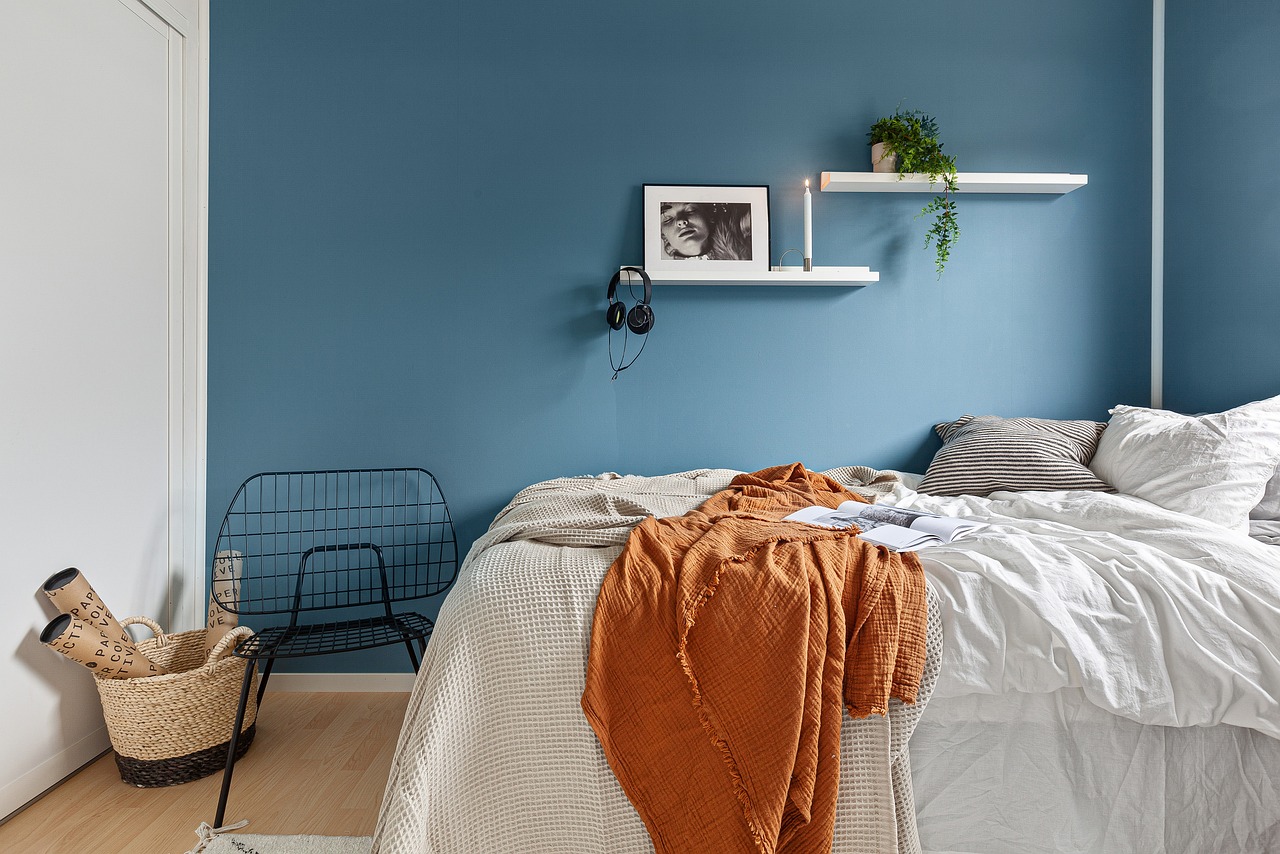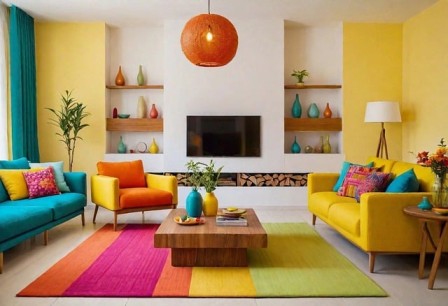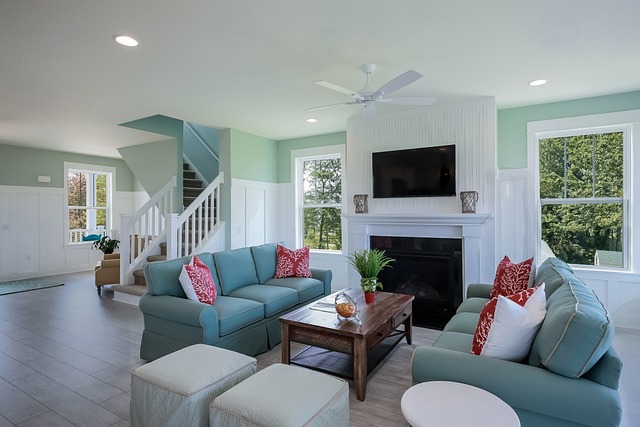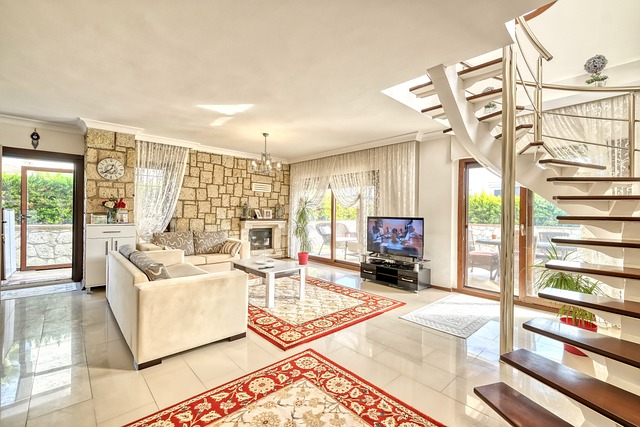Rectangular living rooms are the most common room shapes in modern and traditional homes alike.
They offer an abundance of layout possibilities, but without the right planning, the space can feel awkward or unbalanced.
Whether long and narrow or wide and elongated, a rectangular room presents both challenges and exciting opportunities for interior design.
At PaintingGlobe.com, we’re all about helping you transform your space with intentional design that doesn’t stop at paint colors.
The right furniture arrangement can turn your rectangular living room from cramped and confusing to stylish and functional.
This guide explores the best furniture layout ideas for rectangular living rooms, complete with visuals, design tips, and practical strategies for every kind of lifestyle and need.
Why Layout Matters in a Rectangular Living Room
A good furniture layout enhances the following:
- Functionality: It determines how easily people can move around.
- Comfort: Placement affects where and how you relax.
- Aesthetics: A balanced layout complements your décor and paint.
- Socialization: Smart arrangements facilitate conversations and interactions.
The shape of the room should influence your design strategy. Rectangular spaces often benefit from zoning (creating distinct areas within the space), focal points, symmetry, and movement pathways.
Step-by-Step Planning Before Arranging Furniture In Rectangular Living Rooms
1. Measure Your Space
Before making any design decisions:
- Measure the full length and width of the room.
- Note architectural features: doors, windows, pillars, fireplaces, wall sockets, etc.
2. Define the Purpose of the Room
Is it for:
- Watching TV?
- Entertaining guests?
- Reading and relaxation?
- A multi-functional space (living + dining)?
Clarifying the room’s primary use will influence your furniture choices and arrangement.
3. Identify the Focal Point
Every great layout has a visual anchor. This could be:
- A TV or media console
- A fireplace
- A large window or artwork
- An accent wall with a bold paint color
4. Create Zones
In longer rectangular rooms, zoning can break the space into manageable areas. For example:
- A lounge area
- A study nook
- A reading corner
- A dining space
Best Layout Ideas for Rectangular Living Rooms
Let’s explore the most effective layout styles that work for both large and small rectangular living rooms.
1. The Classic Symmetrical Layout
Best for: Traditional aesthetics, formal living rooms
How it works:
- Place a large sofa along one long wall.
- Add two armchairs directly opposite the sofa, with a coffee table in between.
- Position a media console or fireplace on one short wall.
- Anchor with a large rug for cohesion.
Tips:
- Maintain symmetry on either side for balance.
- Great if you want a clean, organized look.
2. L-Shaped Seating Arrangement
Best for: Casual living spaces, open-plan homes
How it works:
- Use an L-shaped sectional or two sofas arranged at a right angle.
- Place a coffee table in the center.
- Use the corner of the room or a rug to anchor the seating area.
Benefits:
- Maximizes seating in tight spaces.
- Encourages a cozy and intimate feel.
- Ideal for TV watching and family gatherings.
3. Floating Furniture Layout
Best for: Larger rectangular living rooms
How it works:
- Pull furniture away from the walls.
- Float a sofa and chairs around a central coffee table.
- Use a rug underneath to define the seating zone.
Benefits:
- Opens up wall space for storage, shelving, or art.
- Creates better flow and visual balance.
- Makes the room feel airy and spacious.
4. Zoned Dual-Purpose Layout
Best for: Multi-functional living rooms
How it works:
- Divide the room into two distinct areas.
- One end could be a TV/lounging area.
- The other end could serve as a reading nook or small office.
- Use a console table, bookshelf, or rug to divide the space.
Tips:
- Coordinate color schemes to keep cohesion.
- Lighting (like pendant lights or floor lamps) helps define zones.
5. The Narrow Room Solution
Best for: Long, narrow rectangular living rooms
How it works:
- Place a long sofa against one wall.
- Use slim, armless chairs or benches opposite.
- Choose narrow coffee tables and furniture with legs to reduce visual weight.
Extra Tip:
- Use mirrors on one wall to create a sense of depth.
- Paint the shorter walls a darker shade to visually “shorten” the room and reduce tunnel effect.
6. Corner Sectional + Accent Chairs
Best for: Relaxed, modern family rooms
How it works:
- Position a large sectional in one corner.
- Add one or two accent chairs to complete the seating.
- Place the media console on the opposite wall.
Tips:
- Ensure the sectional doesn’t block walkways.
- Use throw pillows and layered lighting to soften the look.
7. Minimalist Layout
Best for: Small rectangular living rooms or minimalist styles
How it works:
- Choose compact furniture: a small sofa or loveseat, one chair, and a side table.
- Keep furniture off the walls where possible.
- Emphasize negative space and clean lines.
Benefits:
- Makes small rooms feel larger.
- Easy to maintain and reconfigure.
8. The Conversational Circle
Best for: Entertaining, hosting guests
How it works:
- Arrange seating in a circle or semi-circle.
- Place a coffee table in the center.
- No seat should be more than 10 feet apart to keep conversation easy.
Variations:
- Use ottomans and poufs for flexibility.
- Perfect for rectangular rooms used for social gatherings.
9. TV-Centric Layout
Best for: TV and media lovers
How it works:
- Place the TV on a short wall (not a long one).
- Arrange a sectional or sofa directly facing it.
- Add side chairs angled slightly toward the screen.
- Use media consoles, shelves, or paint behind the TV wall to emphasize it as a focal point.
10. Layout for Open Plan Living + Dining
Best for: Combined spaces in rectangular floor plans
How it works:
- Divide space into “living” and “dining” halves.
- Use a sofa or console table as a boundary between zones.
- Keep a cohesive color palette to unify the room.
Suggestions:
- Position the dining table closest to the kitchen or light source.
- Use rugs to define each area.
Professional Furniture Placement Tips for Rectangular Living Rooms
- Leave Walkways: Ensure 30–36 inches of walking space between furniture pieces.
- Play with Angles: Diagonal placement can soften the boxy feel of rectangular rooms.
- Use Rugs to Anchor Zones: Especially useful in long rooms or open plans.
- Layer Your Lighting: Use a mix of overhead lights, lamps, and wall lights to add depth and comfort.
- Float Your Furniture: Don’t be afraid to move pieces away from the walls.
- Add Mirrors: They visually widen the room and reflect light beautifully.
- Paint Strategically:
- Use lighter shades to open up space.
- Try an accent wall to break up the length.
- Use horizontal stripes or painted panels to widen the visual field.
- Use lighter shades to open up space.
Common Mistakes Yous Should Avoid
- Pushing all furniture against the walls: This can make the room feel cold and empty.
- Ignoring traffic flow: Awkward pathways discourage use.
- Oversized furniture: Avoid bulky sofas in narrow spaces.
- Not creating zones: One long stretch of furniture feels disorganized.
- Clashing colors or styles: Uncoordinated elements create visual clutter.
Popular Furniture Pieces for Rectangular Rooms
Here’s a breakdown of the best types of furniture for rectangular layouts:
| Furniture Type | Why It Works |
| Sectional Sofa | Maximizes seating and fits corners well |
| Slimline Sofa | Great for narrow layouts |
| Armless Chairs | Save space, easy to reconfigure |
| Console Tables | Good for zoning and behind-sofa setups |
| Nesting Tables | Versatile and compact |
| Open Bookshelves | Define space without closing it off |
| Poufs & Ottomans | Flexible and portable seating |
Conclusion
Rectangular living rooms don’t have to be tricky. With the right layout strategy, they can become the most dynamic and inviting rooms in your home.
From zoning techniques and focal points to sectional sofas and minimalist styles, the key is balance, balancing comfort with flow, aesthetics with function.
At PaintingGlobe.com, we believe that good design begins with intention. And just like the perfect paint color, the perfect furniture arrangement can make all the difference.






























